** WARNING: This is a blatant cut and paste job from Sightline Daily **
The writer did an AMAZING job, so why recreate the (bike) wheel
___________________________________________________________________________________
Two Wheels and High Heels
Ten lessons from the great cycling cities.
In
the Seattle suburb where I grew up, the main transportation choice most
residents face is what kind of car to buy. I moved to Seattle after
college and, inspired by the “car-lite” lifestyles of several friends,
decided to give cycling a try.
I fell in love with it. Urban cycling freed me from slow buses,
parking meters, and mind-numbing elliptical machines. I arrived at work
with more energy. I lost weight. I discovered charming neighborhood
restaurants. I could smell fresh laundry and dinners in the oven while I
pedaled home through residential streets. Getting from A to B on my
bike became the best part of my day.
Recently, I won a fellowship and got to spend six months living life
on two wheels in the world’s most bike-friendly cities. I brought home
ten lessons, and thousands of photographs, for Cascadia:
1.) It’s the infrastructure, stupid! Amazing
infrastructure makes cycling normal and safe in bike meccas, but not
yet in the Northwest. For example, parked cars to the left of the bike
lane not only provide a barrier between motorized traffic and cyclists,
they also minimize a cyclist’s chance of getting “doored.” Most cars in
Denmark (pictured) only have one occupant, the driver, and drivers get
out on the left. Same goes for the Northwest.
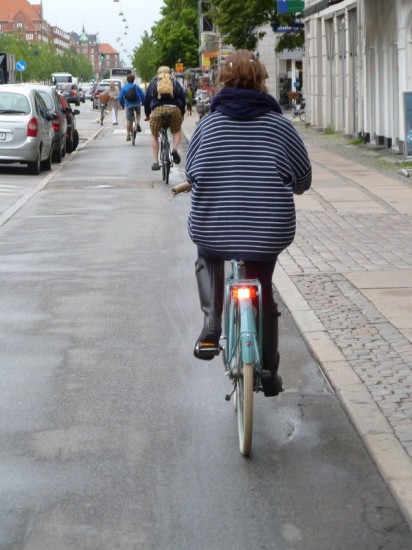 |
| Denmark |
Bikes move at different speeds than cars
or pedestrians, so intersections are safer for cyclists if they have
their own traffic signal rhythm. Cyclists in Copenhagen generally get a
slight head start over cars so that they’ll be more visible as they
cross the intersection. In the picture below, the light is red for cars,
but the smaller light for cyclists is green.
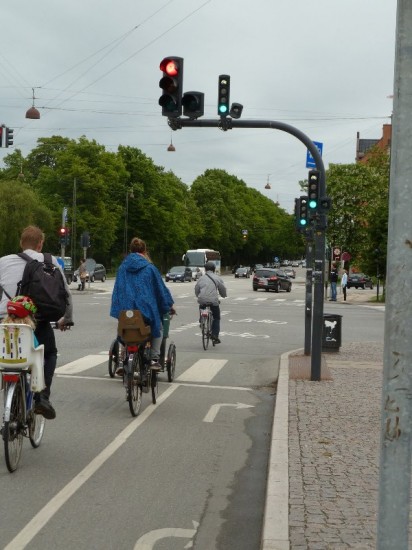 |
| Copenhagen |
2.) Bike share! Bike share! Bike share! Bike share! Bike share! Bike-share programs are sweeping the world but not, as yet,
Cascadia. They are very successful at boosting bike numbers.
Apparently,
people used to point and stare if you were pedaling in Barcelona.
Bicing, Barcelona’s bike share program, has changed that in just a few
years. Bicing started in 2007 and quickly tripled cycling trips
according to Miquel Ruscalleda, who directs Barcelona’s cycling efforts.
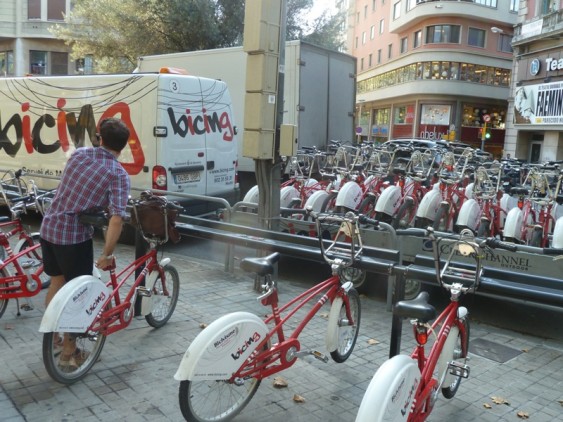 |
| Barcelona |
Currently 46 percent of the people you see on bikes in Barcelona are on bright red Bicing bikes.
 |
| Barcelona |
Ruscalleda also reports that the “safety in numbers” phenomenon is
working in his city. Cyclists had a .008 percent chance of being in a
traffic accident in 2005 and the rate has dropped to around .005 percent
presently. About
130,000 trips are made each day in Paris on public bikes thanks to the Vélib’ bike-share program.
3.) It’s safer than a sofa. Sedentary
living doubles the risk of cardiovascular diseases, diabetes, and
obesity. Combating diseases of sedentary living requires 30 minutes of
moderate exercise every day—a minimum more and more people around the
world are
unable to meet.
“Why not introduce a broad, carefully conceived invitation to people to
walk and bicycle as much as possible in connection with their daily
activities?” asks Jan Gehl, a Danish urban quality consultant. Almost 40
percent of Copenhagen residents meet their minimum exercise
requirements by cycling to work or school. Copenhagen’s Public Health
Department calculates that even when accident costs are factored in,
every mile of cycling translates to net health benefits worth US$1.30. A recent public health campaign in Copenhagen reminded residents that, “
you’re safer on your bike than on the sofa!”
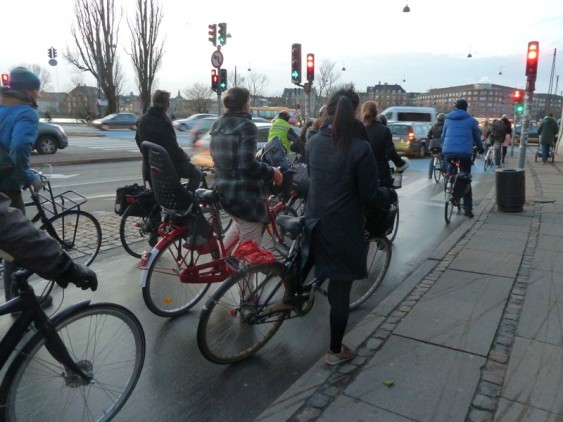 |
| Copenhagen |
4.) Say “thank you.” Cyclists
also save city governments money by reducing traffic congestion,
stormwater run-off, air pollution, and road maintenance expenditures.
Many cities are doing little things to show their gratitude. Barcelona
recently installed a counter on a main route displaying the time,
temperature, bike count for the day and progress toward the official
annual ridership goal for that route.
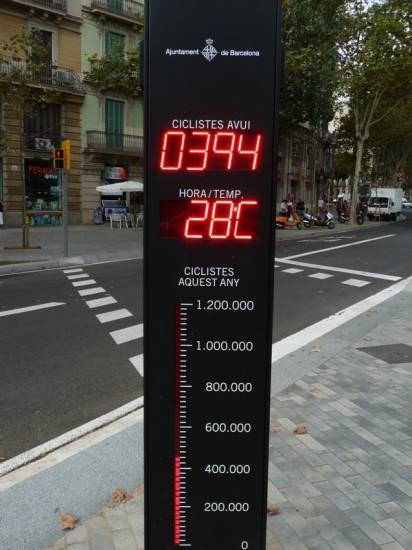 |
| Barcelona |
Copenhagen has begun putting in footrests at intersections. They say,
“Hi, cyclist! Rest your foot here…and thank you for cycling in the
city!”
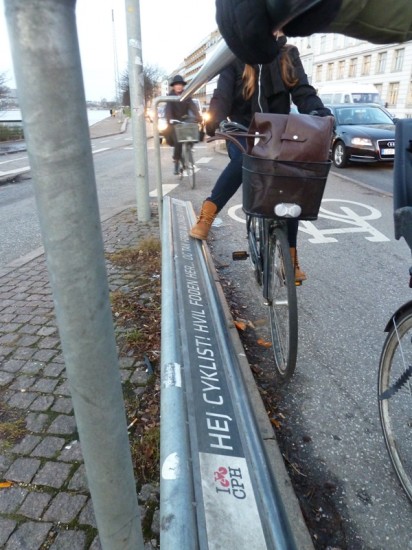 |
| Copenhagen |
5.) Forget speed bumps and “children at play” signs: turn streets into backyards. Dutch
road engineer Hans Monderman hated traffic signs in cities and towns.
His reasoning was simple. Most drivers don’t look at signs. Speed bumps
and stop signs also don’t do much because drivers are notorious for
accelerating to “make-up time” after each interruption. Monderman
redesigned Dutch towns so that drivers felt like they were passing
through someone’s backyard. Monderman’s “backyard”
plans called
for street furniture—benches, picnic tables, sand boxes, pea patches,
trees, flowerpots, and ping pong tables. Drivers either saw or sensed
the presence of people and children, and basic social laws kicked in. It
isn’t polite to speed through someone’s backyard. Many residential
streets throughout Europe, like the one pictured below in Basel,
Switzerland, now embody
Monderman’s principles.
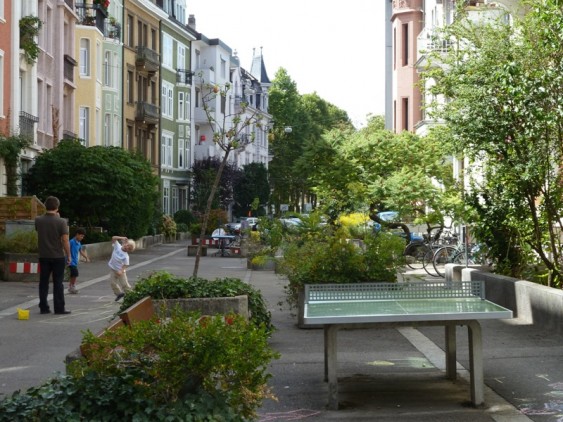 |
| Basel, Switzerland |
6.) Let prices tell the truth. Donald Shoup, an economist and the author of
The High Cost of Free Parking
says, “People who want to store their car shouldn’t store it on the
most valuable land on the planet, for free.” Street parking is typically
$4.50 per hour in European cities. Filling up a tank of gas in Japan
will cost you about $7.25 per gallon, and gas prices in most European
countries are also much higher than in the Northwest.
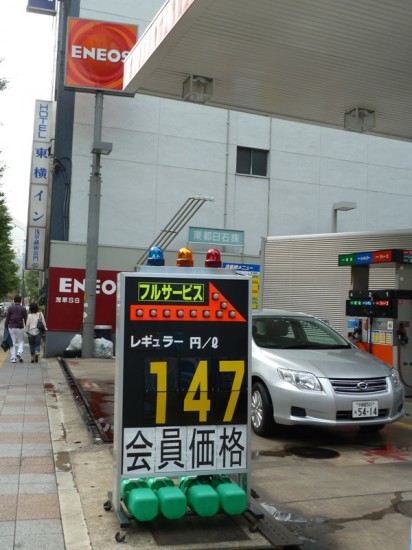 |
| Japan |
7.) You don’t need “bike clothes.” Most
of the women and men I saw on bicycles throughout Europe and Japan
didn’t wear special clothes. People just wore their usual outfits, heels
and all.
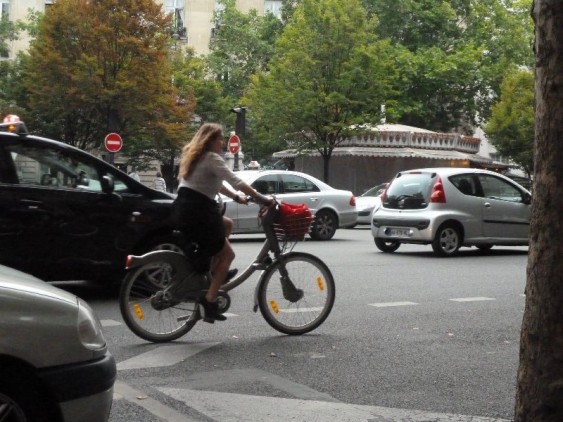 |
| Paris |
Women from London to Tokyo looked beautiful, stylish and feminine while they were cycling.
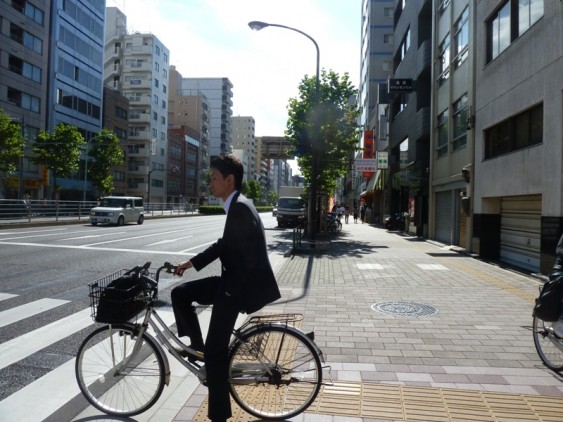 |
| Tokyo |
Men frequently pedaled in suits.
 |
| Kyoto |
“Style over speed,” says Mikael Colville-Anderson who started the
Cycle Chic movement.
8.) Electrify it. A cargo bike with two kids and groceries (below) can be hard to get up hills.
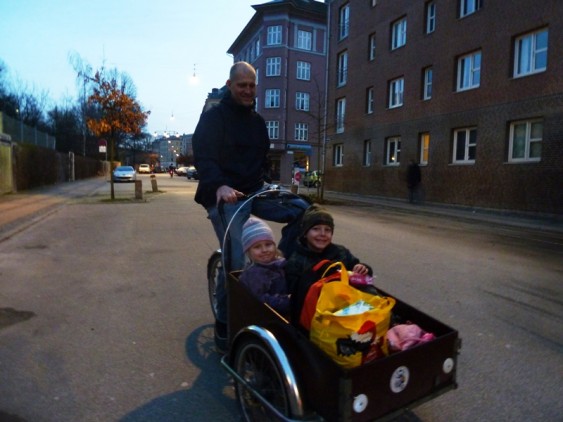 |
| Copehagen |
That’s why many parents in hilly Zurich, Switzerland, use
electric-assist bikes. They can also help people who are battling
obesity or recovering from a heart attack. A
bike shop
owner I interviewed in Zurich makes custom electric-assist bicycles
(below) for disabled customers who would otherwise be dependent on
public transportation.
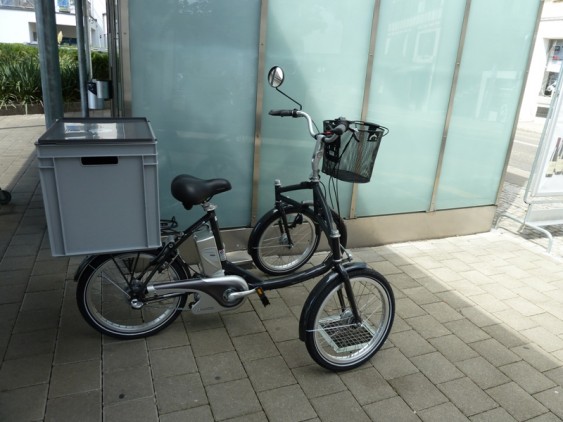 |
| Zurich |
9. ) Admit it: It’s emotional.
Smell and touch are the senses most linked to our emotions. In Europe
and Japan, I spoke with dozens of urban cyclists who talked about the
curious happiness derived from activating your senses and connecting
with your city on a bicycle. One Amsterdam father’s voice actually
cracked with emotion as he reflected on his morning and afternoon rides
with his son. His toddler sat in a front-mounted childseat. The father
talked about how nice it was to smell his son’s head during the commute
to day care. Spending a fraction of the day exposed to the elements is
refreshing for many people and the human-pace of cycling allows us to
notice details about our community that we’d otherwise miss.
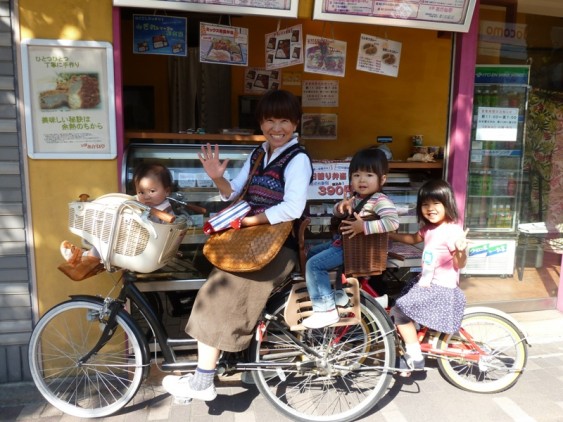 |
| Kyoto |
10.) It’s a virtuous circle—or cycle. “Cycling isn’t just a part of the Dutch DNA,”
Marc van Woudenberg told me in Amsterdam—where
47 percent
of residents make at least one trip per day on a bicycle. The Dutch
have the highest rates of utility cycling in the world because citizens
have made it clear to politicians that cycling infrastructure is a
priority. Better infrastructure recruits more people onto bikes, which
creates more advocates for better infrastructure, which recruits more
people onto bikes, and so on. Today, the Dutch continue to advocate for
infrastructure that will facilitate cycling—like this secure bike
parking facility at the train station in Groningen, Holland.
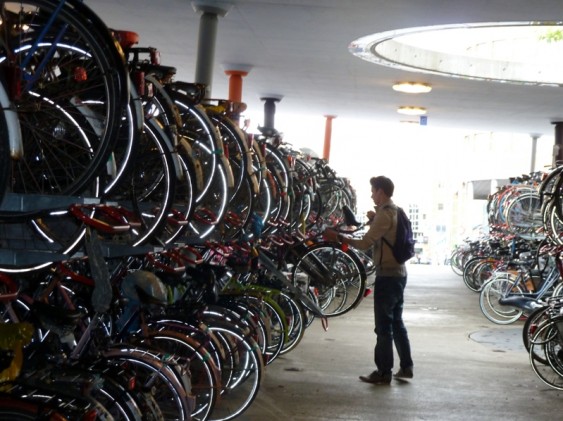 |
| Groningen, Holand |
After six months on my bicycling
wanderjahr, I’m inspired by all the creative ways cities are transforming themselves to meet the needs of the 21
st
century: low on carbon, high on physical activity, low on noise and
danger, high on fun and style. Here in Cascadia, we have exciting
opportunities to join the world’s great bike cities and redefine urban
transportation on two wheels.
Christine M. Grant frequently wears heels when she cycles in Seattle. You can read more about the cycling cities she visited on her blog Shift. Alan Durning edited this post.
















No comments:
Post a Comment